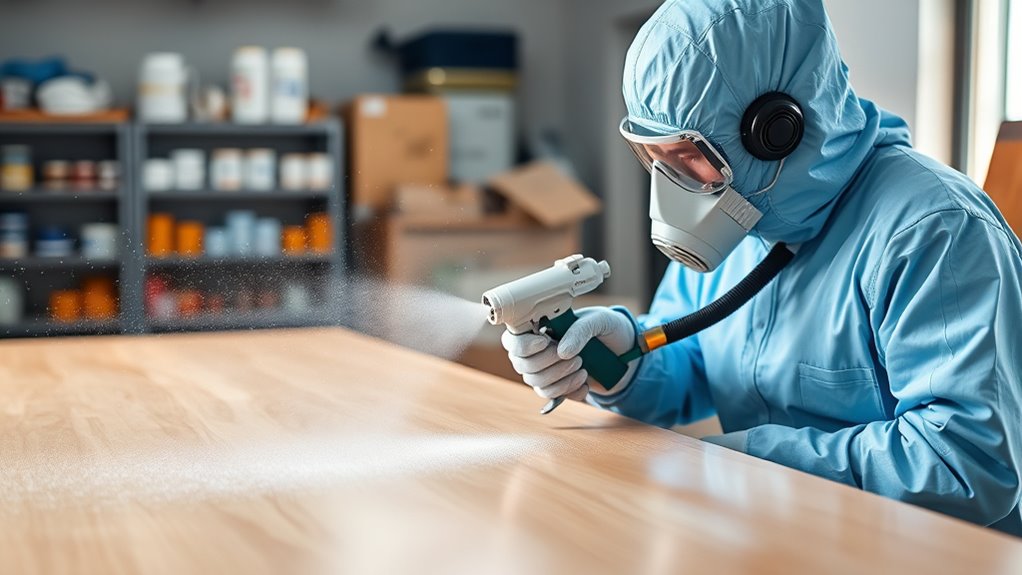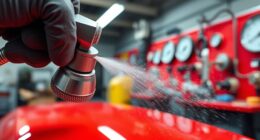To spray low-VOC and waterborne coatings effectively, start by using high-quality spray equipment suited for these products, adjusting settings according to manufacturer guidelines. Keep a consistent distance from the surface, typically around 6–12 inches, and apply multiple thin coats with steady, overlapping strokes. Work in well-ventilated areas wearing proper PPE. Maintaining cleanliness and monitoring environmental conditions will guarantee a smooth finish; if you continue, you’ll discover even more tips for professional results.
Key Takeaways
- Use high-quality spray equipment designed for waterborne/low-VOC coatings and test settings on scrap material first.
- Maintain a consistent distance (6–12 inches) and use steady, overlapping motions for even application.
- Apply multiple thin coats instead of one heavy coat to improve coverage, adhesion, and finish quality.
- Work in well-ventilated areas with appropriate PPE, including respirators rated for low-VOC fumes, gloves, and eye protection.
- Monitor environmental conditions like humidity and temperature to optimize drying, adhesion, and overall coating performance.

Spraying low-VOC and waterborne coatings offers a safer and more environmentally friendly alternative to traditional solvent-based paints. When you decide to switch, understanding the right application techniques is essential to achieve a smooth, professional finish. These coatings typically require different handling compared to conventional paints, so paying close attention to your spraying method ensures ideal results. First, you need to prepare your equipment properly. Use a high-quality spray gun designed for waterborne or low-VOC materials, as these often have different viscosity and flow characteristics. Adjust the spray pattern and pressure according to the manufacturer’s recommendations, which helps prevent issues like overspray, runs, or uneven coating. Always test your spray setup on a scrap piece before starting your main project to fine-tune your technique.
Applying low-VOC and waterborne coatings demands that you maintain a consistent distance from the surface, usually about 6 to 12 inches, depending on the product and spray gun. Keep your movements steady and overlapping slightly with each pass to avoid streaks or missed spots. Multiple thin coats tend to provide better coverage and adhesion than one heavy coat, so plan your application process accordingly. Be mindful of environmental factors like temperature and humidity, as these can affect how the coating sprays and dries. Cooler or more humid conditions may slow evaporation, so you might need to adjust your technique or timing.
Safety precautions are essential when working with these coatings, even though they are less toxic than traditional options. Always wear personal protective equipment such as a respirator rated for waterborne or low-VOC fumes, gloves, and eye protection. Adequate ventilation is fundamental; work in a well-ventilated space or outdoors to minimize inhalation of airborne particles and vapors. Avoid eating or drinking around your work area, and wash your hands thoroughly after finishing. Be cautious about cleanliness, as waterborne coatings can be more sensitive to contamination, which can compromise the finish. Properly dispose of any used rags, filters, or leftover material, following local regulations to prevent environmental contamination.
In addition to protective gear, you should also be aware of the potential health effects and take steps to minimize exposure. Keep your work area free of dust and debris that could settle on the wet coating. Cover nearby surfaces to prevent overspray from settling where it shouldn’t. Developing a good understanding of sound wave science can help optimize spray techniques and improve application quality. By mastering application techniques and adhering to safety precautions, you can enjoy the benefits of low-VOC and waterborne coatings while maintaining a safe workspace and achieving excellent results.
Frequently Asked Questions
Can I Use Standard Spray Equipment for Low-Voc Coatings?
You can use standard spray equipment for low-VOC coatings, but you need to verify equipment compatibility first. Some equipment may require modifications to handle waterborne or low-VOC formulas properly. Using the right spray technique is essential, as waterborne coatings tend to be more sensitive to overspray and atomization issues. make certain your equipment is compatible and adjust your spray technique to achieve a smooth, even finish without wasting material or compromising quality.
How Do I Clean Spray Equipment After Using Waterborne Coatings?
Imagine your spray equipment as a garden hose after watering delicate plants; it needs careful rinsing to keep it flowing smoothly. You should start by draining remaining waterborne coatings, then fill the cup with cleaning solvents suited for waterborne paints. Run the solvents through the system, and disassemble parts for thorough equipment maintenance. Finish by rinsing with clean water, ensuring all residues vanish, so your tools stay in prime condition for next use.
Are Low-Voc Coatings Suitable for Outdoor Projects?
Yes, low-VOC coatings are suitable for outdoor projects because they reduce environmental impact and emit fewer fumes. However, consider durability considerations, as some low-VOC formulations may not last as long in harsh weather conditions. You should select a product specifically designed for outdoor use, ensuring it offers weather resistance and long-lasting protection. Proper surface preparation and application help maximize durability and environmental benefits.
What Safety Precautions Are Necessary When Spraying Waterborne Coatings?
Imagine you’re spraying waterborne coatings on a porch. Always wear protective gear like gloves, goggles, and a respirator to prevent inhaling fumes or getting splashes on your skin. Make certain your ventilation setup is proper—use fans or open windows—to keep fumes away and maintain airflow. These safety precautions help protect you from potential health risks, making your project safer and more comfortable.
How Do I Troubleshoot Uneven Spray Patterns With Low-Voc Paints?
To fix uneven spray patterns with low-VOC paints, first check your spray pressure; too high or low pressure causes inconsistency. Adjust it according to your paint’s manufacturer recommendations. Next, evaluate your nozzle selection—using the correct nozzle size and type ensures a smooth, even spray. Regularly clean your nozzle to prevent clogging, which can also lead to uneven application. Properly tuning these variables will improve your spray pattern markedly.
Conclusion
By mastering how to spray low-VOC and waterborne coatings, you hold the brush that paints a greener future. Every careful spray is a drop of hope, a step toward cleaner air and healthier spaces. Remember, your technique isn’t just about finishing a project—it’s about leaving a lasting mark of sustainability. With each stroke, you become a guardian of the environment, turning your craftsmanship into a symbol of change that echoes beyond the surface.
Franz came aboard the Paint Sprayer Zone team with a background in both journalism and home renovation. His articulate writing style, combined with a passion for DIY projects, makes him an invaluable asset. Franz has a knack for breaking down technical jargon into easy-to-understand content, ensuring that even the most novice of readers can grasp the complexities of paint sprayers.










